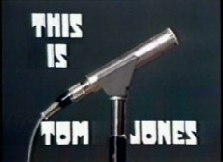
TV Pop Diaries
Pop Music on British Television 1955 -
Thomas The Jones or Jones The Voice, depending on what Radio One DJ was broadcasting at the time, had struck it big in America almost straight away. By the end of his first eighteen months at Decca he had recorded three Hollywood movie themes, Promise Her Anything, What's New Pussycat and Thunderball. His own TV series on ATV had done well, but it was made in black and white, so if he was to now break American TV the colour/color cameras at Elstree had to be booked.
Melody Maker announced in June 1968 "A sensational five-
Tom had only recently completed recording a six-
The show was expensive, with each show costing something like £100,000, as TV Times put it "four or five times that for most British 'spectaculars'."
Each show opened with Jones' signature tune It's Not Unusual and would close with
a version by the studio band. The musical arranger on the show was Johnnie Spence
who also worked on the subsequent LP release This Is...Tom Jones, while Jones' regular
guitarist Big Jim Sullivan would feature in a solo spot in later editions, and was
even given a chance to speak. However, this seemed to be the end for Jones' backing
band The Squires with their drummer Chris Slade joining the Olivia Newton-
The show's finale each week (later referred to as the Concert Spot) saw Jones in his element, knocking out high octane rock and roll or rhythm and blues numbers with the band behind him. Adoring women grabbed at him, but the screams seemed dubbed on later.
The pilot show, shot at Elstree in September 1968 featured Mirielle Mathieu, The 5th Dimension and Juliet Prowse, demonstrating the hopes for international sales.
The UK version of the first series was shot in black and white with American colour cameras alongside them, leading to different shots, something that British TV was used to with Rediffusion's Hippodrome in 1966 and the final ATV series of The Morecambe and Wise Show in 1967.
ITV's midlands franchise ATV who produced the UK version of the show at Elstree studios relegated it to a late night Sunday slot, while London Weekend moved it to Friday after the first few were broadcast in prime time on Sundays. The early shows were directed by veteran Rita Gillespie, who had been at the helm of Oh Boy, Putting On The Donegan, Around The Beatles and many others and would later go on to work for Jerry Lee Lewis in America.
The first show in the series becomes ITV's entry in the Montreux TV Festival in April 1969.
Series two saw blocks of recording, beginning 18th October 1969 in Elstree, which would then be edited into nineteen shows with Mary Hopkin, The Who, Jose Feliciano and American comic Shelley Berman for show one, Wilson Pickett and actress Barbara Eden for show two, The Moody Blues and Connie Stevens for show three and Cass Elliott, The Hollies and Charles Aznavour for show four. Further recording in November involved Dusty Springfield, Bobbie Gentry, Harry Secombe, Frankie Vaughan, Nancy Wilson, Judy Collins, Liza Minnelli and Victor Borge. Comedy was provided by the Ace Trucking Company, featuring Fred Willard, later a regular in Christopher Guest's repertory company, while Tony Hendra who also appeared in Spinal Tap with Willard turned up with his comedy partner Nick Ullett.
The final 18 shows were taped at Elstree from October 1970 onwards, but despite his continuing success in the UK charts the final series, broadcast in 1971, was buried by ITV in the schedules on a Thursday evening after News At Ten.
From the perspective of the 21st century when Jones is now rightly seen as a national treasure its not difficult to see why the show was seen as passe at the time. The comedy was crowbarred in just as it was with Cliff, Cilla, Lulu, Dusty and company. But look past the bad comedy and you'll see Jones is in his element here, and as a bonus the show also featured the cream of pop royalty. Janis Joplin, The Who, Crosby Stills Nash & Young, Ella Fitzgerald, Little Richard, The Bee Gees, The 5th Dimension and many others. The show saw Jones in transition from beloved British superstar to Vegas lounge act, which would be his day job for the next fifteen years until his British renaissance in 1987.
Prints of the show still exist, but seem mostly to be the American edits.
THIS IS TOM JONES
ATV
12th January 1969 -
